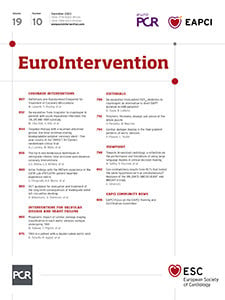Cardiovascular disease remains a significant global health concern, and percutaneous coronary intervention (PCI) has undergone remarkable advancements, transforming the management of coronary artery disease (CAD). The introduction and continuous technological enhancements of drug-eluting stents (DES) have notably reduced the need for repeat revascularisations, as compared to bare metal stents (BMS)1. Newer-generation DES exhibit improvements in all key components, including the metallic scaffold, the active antiproliferative agent, and the polymer coating2. Modern materials like cobalt-chromium have allowed for a gradual reduction in strut thickness, promoting faster endothelialisation while preserving both outer radial strength and radio-opacity3. Additionally, the transition from paclitaxel to the -limus family has significantly improved clinical outcomes4. However, concerns have arisen regarding the endothelial inflammatory response related to the persistence of the polymer coating. Biodegradable-polymer (BP) coatings have been conceived to mitigate the device-related risk of recurrent events by facilitating vascular healing while minimising the persistent inflammatory response related to durable polymer (DP). Potential benefits of the biodegradable-polymer DES are expected at long-term follow-up, and the focus in recent years has been directed towards investigating whether the safety profile of biodegradable polymer is sustained and magnified over time5.
The Targeted Therapy With a Localized Abluminal Groove, Low-Dose Sirolimus-Eluting Biodegradable Polymer Coronary Stent (TARGET All Comers) trial, the 1- and 3-year results of which have been previously published67, randomised 1,653 patients across 10 European countries to PCI using either the BP sirolimus-eluting stent (BP-SES), FIREHAWK (MicroPort), or the DP everolimus-eluting stent (DP-EES), XIENCE (Abbott).
At 1-year follow-up, the FIREHAWK BP-SES met the non-inferiority endpoint of target lesion failure (TLF) as compared to the XIENCE DP-EES. Neither TLF (6.1% vs 5.9%, respectively) nor the secondary outcomes significantly differed between the two stents. Notably, stent thrombosis occurred with similar frequency in both groups6. The 3-year results revealed comparable rates of TLF (11.9% vs 11.5% for FIREHAWK BP-SES and XIENCE DP-EES) and other secondary endpoints. Landmark analysis between 1 and 3 years demonstrated no significant differences in the performance of the two devices; however, a trend towards fewer very late definite or probable stent thromboses, favouring the FIREHAWK BP-SES (0.8%), was observed after 12 months as compared to the XIENCE DP-EES (1.4%)7. Despite being rare, these events could be interpreted as a sign of a lower thrombogenicity favoured by the bioresorbable polymer.
In this issue of EuroIntervention, Lanksy and colleagues report the long-awaited 5-year results of the TARGET All Comers trial which were anticipated to provide insights into the long-term performance of these stents8.
Nearly 94% of patients completed the 5-year clinical follow-up, enhancing our understanding of the long-term performance of these devices. The primary endpoint, TLF, occurred in 17.1% of the FIREHAWK group and 16.3% of the XIENCE group at 5 years, with no statistically significant difference (p=0.68). Similarly, the patient-oriented composite endpoint (POCE), which comprised all-cause death, all myocardial infarctions, and all revascularisations, showed similar rates in both groups. Notably, the previously suggested signs of reduced thrombogenicity with the FIREHAWK were not confirmed, as the rates of definite or probable stent thrombosis (acute, late, and very late) were observed to be comparable between the two study groups. Landmark analyses at 1 year showed no differences in TLF and its components, POCE, or stent thrombosis.
The study can be approached from two distinct perspectives: a purely technical one and a broader, clinical one.
With respect to the technical aspects, the FIREHAWK and the XIENCE share some similarities. They both employ cobalt-chromium for the metallic scaffold and exhibit a comparable strut thickness (86 μm and 81 μm, respectively). However, they incorporate different antiproliferative drugs from the -limus family (sirolimus and everolimus, respectively). Moreover, the FIREHAWK shows a novel feature of a unique set of recessed abluminal grooves containing a D,L-polylactic acid polymer of 10-μm thickness that are able to provide a controlled and targeted release of the antiproliferative drug. The thin polymer coating completely dissolves within 6-9 months.
This finding is part of a broader context of extensive evidence, with some aligning and others conflicting, advocating that other mechanical features may be responsible for the device-related risk of recurrent events910. Besides polymer coatings and drugs, differences in strut thickness and geometry, coating distribution, drug release and polymer degradation kinetics can all have an impact on peristrut local haemodynamics and, ultimately, on re-endothelialisation. Such a wide variety in stent features combined with a low rate of device endpoints in the past decade limit the potential to demonstrate the incremental benefits of newer technologies and overturn the concept of class effect among bioresorbable-polymer DES.
Beyond the technical perspective, this trial provides a highly comprehensive overview of the clinical progression of patients with CAD. The inclusion criteria were intentionally wide-ranging, and the enrolled patients fairly represent the typical caseload encountered in a cath lab on a daily basis. While the absence of significant differences between the two stent types in outcomes is noteworthy, a deeper analysis reveals intriguing nuances. Repeat revascularisation was a major contributor, occurring in 19.3% and 19.2% of the FIREHAWK and XIENCE groups, respectively. Importantly, fewer than one-third of these events were ischaemia-driven and target lesion-related, suggesting that factors beyond stent performance alone, such as patient- and lesion-related characteristics, play a significant role. This finding highlights the complexity of clinical decision-making in CAD management and underscores the need for a nuanced approach that considers not only the stent but also patient-specific factors and the clinical context.
Ultimately, the TARGET All Comers trial reminds us that the path to improving cardiovascular care involves piecing together many elements, with metals, active drugs, and polymer coatings being just a few parts of a 1,000-piece puzzle.
Conflict of interest statement
V. Paradies declares a research grant from Abbott to her institution; has received an educational grant from Terumo; and received speaker fees from Abbott and Boston Scientific. M. Maurina has no conflicts of interest in relation to this manuscript.

